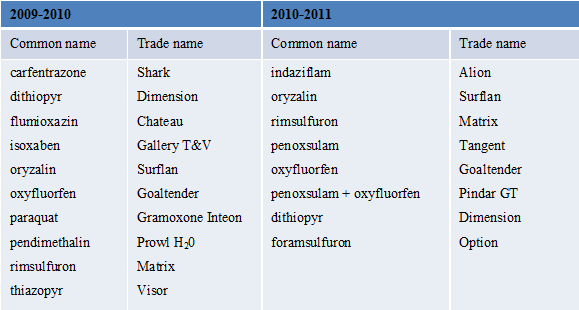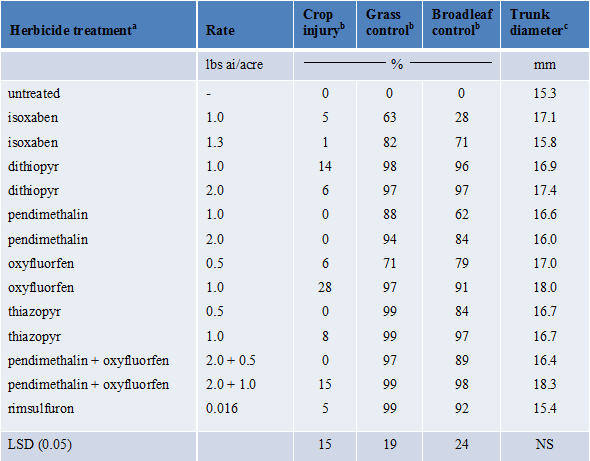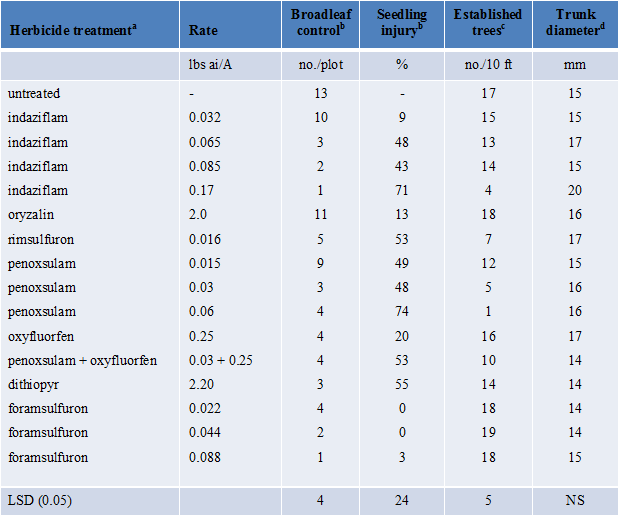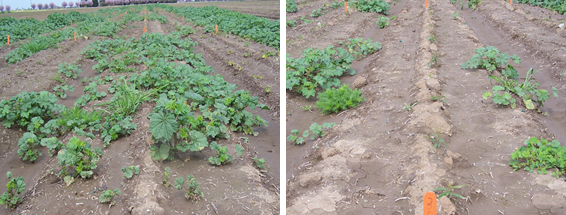Evaluation of Herbicides for Weed Control Efficacy and Crop Safety in Field Production of Nursery Fruit and Nut Trees
by Joi Abit and Brad Hanson
Introduction
Weed control is an ongoing management problem facing nursery growers of field-grown fruit and nut trees. Competition from weeds can decrease crop productivity and interfere with field and harvest operations. Control strategies currently rely on methyl bromide, pre-emergence herbicides, hand labor and multiple tillage operations. Soil fumigation alone often does not provide and maintain a consistently high level of weed control over the entire 1- to 3-year nursery tree-cropping cycle. Some weed species are not well controlled by fumigants due to their biology (impermeable seed coat, dormancy), ecology (airborne invasion, large seed bank), or response to environmental conditions (dry soil). This problem likely will be compounded by use of fumigants other than methyl bromide which is being phased out due to environmental concerns. Hand labor can effectively control weeds within rows of nursery stock but can result in mechanical crop damage, requires access to a large labor force, and is becoming more expensive and subject to greater worker safety regulations.
Therefore, weed control chemicals and techniques will likely become an important part of an integrated pest management strategy in nursery crops as methyl bromide is phased out and fuel and labor cost increase. Several herbicides are labeled for use in tree and vine nurseries but during the critical rootstock emergence and early-season growth period, residual herbicide choices are limited by number of registered materials and by crop safety concerns. Some herbicides can injure either perennial crop root growth (stunting or malformations) or above-ground growth (meristem damage, stem malformations, stunting, chlorosis, or death). Because nursery-grown tree and vines that are produced in the ground are dug up and sold, e.g., as bareroot stock, any root or stem damage is unacceptable to the buyers and these plants are not marketable. Several new herbicides have been registered in orchard crops for control of a broad spectrum of weeds; however, these herbicides are not currently labeled for tree nursery production.
The goals of these field trials were to evaluate weed control efficacy of several pre-emergence and post-directed herbicide treatments, evaluate nursery root-stock safety of the herbicide treatments, and determine the effect of treatments on the health, vigor and productivity of the field-grown fruit and nut trees at harvest. Ultimately these experiments will provide growers and researchers information on weed control efficacy and crop safety with these herbicides.
Methodology
Field trials were conducted from 2009 to 2010 and 2010 to 2011 at commercial nurseries with Nemaguard peach (seeded) and Krymsk86 plum/peach hybrid (cuttings) rootstocks. Prior to planting, nursery blocks were fumigated with either methyl bromide or a dual application of Telone II. Each experiment was arranged in a randomized complete block design with four replications and individual herbicide plots were 3 feet by 25 feet containing a single tree row. Several pre-(PRE) and post-emergence (POST) applications of registered and unregistered herbicides were applied (table 1). PRE treatments were applied after seeding the rootstock but before emergence using a CO2-pressurized backpack sprayer calibrated to deliver 25 to 50 gallons per acre in a 3-foot band. In the POST trials, herbicides were applied using a directed or shielded spray boom as appropriate to minimize crop exposure to the treatment.
Table 1. Herbicide products used.

Crop injury and weed control were monitored throughout the 14-month growing season. Prior to harvest, established trees were counted and trunk caliper was measured.
Results and Discussion
In 2009 to 2010, low weed populations were observed due to either effective fumigation or handweeding operations in all sites. Control of grasses was effective in all treatments except those treated with isoxaben or the low rate of oxyfluorfen, while broadleaf weed control was generally poor with low rates of pendimethalin and oxyfluorfen and both rates of isoxaben (table 2). All treatments resulted in similar Krymsk86 rootstock trunk diameter and demonstrated excellent safety except the high rate of oxyfluorfen which caused significant visual injury. Overall, the most promising materials from a crop safety and weed control standpoint were thiazopyr, dithiopyr, rimsulfuron, and pendimethalin + oxyfluorfen.
Table 2. Effects of POST directed herbicide applications on Krymsk86 plum/peach cuttings in a tree nursery trial in 2009–2010.

a Treatments applied: March 5, 2009
b Evaluated: May 24, 2009
c Measured: October 30, 2009
From 2010 to 2011, all PRE treatments except oryzalin and low rates of indazaflam and penoxsulam provided good to excellent control of broadleaf weeds (table 3). Among the herbicide treatments, foramsulam at all rates caused the least injury to Nemaguard peach seedlings (fig. 1). One month after PRE applications, significant stunting and malformation were observed in plots treated with dithiopyr, penoxsulam + oxyfluorfen, and high rates of indaziflam and penoxsulam. Low seedling establishment was observed in plots treated with rimsulfuron and in plots treated with the highest rates of indaziflam and penoxsulam. Due to large variability in tree establishment throughout this field, no differences in final tree trunk measurements were observed.
Table 3. Effects of PRE herbicide applications on Nemaguard peach seedlings in a tree nursery trial in 2010–2011.

a Treatments applied: January 8, 2011
b Evaluated: April 8, 2011
c Plot size: 3 feet by 25 feet
dMeasured: October 18, 2011

Fig. 1. Seedling establishment and weed control in a plot treated with (A) indaziflam at 0.032 pounds active ingredient per acre (lb. a.i./acre) for the lowest rate and (B) foramsulfuron at 0.044 lb. a.i./acre two months after treatment. Herbicide treatment applied: January 8, 2011
The study showed that application of PRE and POST herbicides provided good to excellent weed control in tree nurseries and caused little injury to rootstocks planted as cuttings but safety was lower in seeded rootstock. However, considerable work on herbicide rates, timing and method of application are needed before these materials can be safely applied to newly planted rootstock on a more broad scale.
M. Joy Abit is Post Doctoral Scholar and Brad Hanson is Cooperative Extension Weed Specialist, Department of Plant Sciences, UC Davis.












